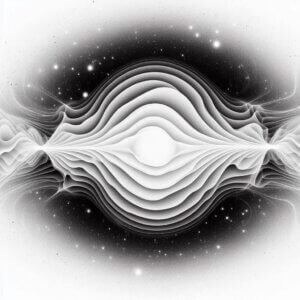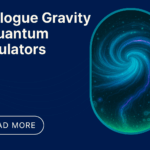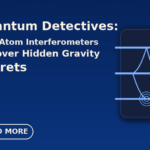
Einstein’s Gravity
The 20th century was a crucial era in the development of modern cosmology. With Einstein’s theory of general relativity (GR) in 1915 and the observational data acquired by Hubble in 1924, cosmology was no longer a topic of philosophical debates but had moved into the arena of science.
General relativity has proven itself to be a powerful candidate in describing the dominant force in the Universe and one of the fundamental forces of Nature, gravitation. It has surpassed Newtonian gravity, passing tests and predicting phenomena that Einstein claimed back in 1915 when he published it, phenomena that Newtonian gravity failed to explain.
It explained the long-sought-after reason behind the perihelion motion of Mercury which had been a mystery before Einstein came along and changed our perspective on how we look at the world. Space is the notion we use when we talk about the universe, but in Einstein’s general relativity, this was only one side of the story. Physical reality lies in a much deeper and fundamental concept than space: Spacetime.
Einstein saw the universe as this structure capable of bending and curving, giving rise to geodesics; trajectories along which objects such as planets, stars and particles of light move on through this four dimensional spacetime. This insight laid the foundation to general relativity. The metric tensor gμν, which describes the geometry of spacetime, is the solution to Einstein’s field equations (EFE):
Equation (1) describes the behaviour of the cosmos. Knowing the geometry of spacetime, the dynamics of the universe and its content can be extracted. Armed with this idea, general relativity predicted many cosmic events, like light bending, gravitational redshift, and gravitational waves—all of which have been confirmed. The latest was gravitational waves, detected by LIGO and VIRGO in 2016, 100 years after Einstein predicted them.
It did not take Einstein much time to apply his theory on the universe as a whole (1917), thus founding the field of relativistic cosmology. He described the universe as a static non-expanding structure.
The years between the 1920 and 1930 were full of attempts to find models describing the behaviour of the universe, notably the work done by Friedmann, Lemaître, Robertson and Walker, who independently developed what is today known as the standard model of modern cosmology, the FLRW model. This model defied Einstein’s view of a static universe, and rather presented an expanding one. Hubble’s data on galaxy redshifts indicated that the universe is indeed expanding. Later astrophysical data from the WMAP and the Planck satellite strengthened the evidence, and an expanding universe today is a scientific fact.
An expanding universe would also mean that at some point this universe had a beginning. This idea was already foreseen from the Friedmann equations of the FLRW model, that exhibit a spacetime singularity, the beginning of the evolution of the universe which we call today the Big Bang.
In short, with the accurate predictions of the theory and the support of observation, it is very difficult today to imagine doing modern astrophysics and cosmology without the general theory of relativity. It is one of the pillars of modern physics.
However, and despite its success and power to describe the universe, general relativity is incomplete, and we know so from both mathematical and cosmological reasons.
Mathematical Incompleteness of General Relativity
From a mathematical point of view, there are two main reasons to consider that general relativity is incomplete. First major issue with GR is the presence of singularities—points where the equations break down, leading to infinities or undefined values. In physics, infinities indicate that a theory needs improvement. In GR, singularities appear in black holes and cosmological models (like the Big Bang), signaling that Einstein’s equations fail in extreme conditions.
The second issue is non-renormalizability of Einstein’s gravity which leads to the difficulty to reconcile general relativity with quantum theory; the other cornerstone of our current understanding of world of the subatomic and particle physics.
Quantum mechanics and the later-developed quantum field theory, a special relativistic quantum theory of fields, is another pillar of modern physics. It describes particle dynamics and interactions governed by the three fundamental laws of nature: electromagnetism, the weak and strong nuclear force.
However, any attempt to add gravity to this quantum picture, would be an attempt to cross a mine field.
Gravity, being a field theory, should be quantizable the same way the other three fundamental forces of nature are.
1. Quantum Electrodynamics (QED) is the quantum field theory of the electromagnetic interaction.
2. Quantum Chromodynamics (QCD) that of the strong interaction, and
3. Quantum flavordynamics (QFD) that of the weak interaction.
All of which are renormalizable theories, i.e they do not show any divergences and their equations make physical sense. But the same quantization procedures do not work for gravity. Gravity, in the picture given by general relativity, is simply a perturbatively non-renormalizable quantum field theory for reasons beyond the scope of this article.
It would be of course easier to just add the word quantum to gravitational interaction and obtain something like ” quantum gravitodynamics (QGD) ” and that would be the end of the problem, but that’s not how quantization procedures work. And so we are bound to find other approaches for a quantum theory of gravity.
I would like to note that although gravity cannot be described in a renormalizable quantum field theory, that does not necessarily mean that one cannot study quantum field theory in the presence of gravity. When adding the metric tensor to any quantum field theory, one enter the realm of quantum field theory in curved spacetime (QFTCS), where the metric introduced here would be fixed. But that shouldn’t be the case in a theory of gravity and thus QFTCS is not equivalent to a quantum field theory of gravity. QFTCS therefore is not designed to be a quantum theory of gravity, but serves as a good tool to reveal some good features of particle interactions in curved space.
Cosmological Problems of General Relativity
The FLRW model or the standard model of cosmology is based on Einstein’s gravity explains the dynamics and evolution of the universe. However it does not predict several observational data. Why is the universe incredibly close to being spatially flat? How come two causally disconnected points in the sky are in thermal equilibrium? Why is there more matter than antimatter? And finally, where did all the monopoles go?
Such questions could not be answered by the standard model of cosmology which forced cosmologists to come up with modified models by adding different fields that general relativity on its own does not explain their existence. Inflation was one of these models. It predicts a period of exponential expansion in the early universe which potentially solves the problems posed by the above questions. But nonetheless, there remains skepticism towards inflation for multiple reasons and questions that still remain unanswered even with the inflationary scenario. Where did the inflaton field, the field responsible for inflation, come from? How long was the period of inflation and why did it end? Furthermore, inflation does not tell us what is the origin of the density perturbation and why the initial conditions are the way they are, rather they should be put by hand.
The answers to all these mathematical and cosmological problems are beyond the capability of general relativity and the standard model of cosmology and any of its extensions, and this is an indication that general relativity is not the complete nor final theory of gravity. Rather, there is a much deeper and fundamental theory into play here waiting to be discovered, and this has opened Pandora’s box to the yet-to-be-discovered next big theory of quantum gravity.
Quantum Gravity
The search for a theory of quantum gravity has been ongoing for nearly eighty years now. None of the attempts made so far have been fully consistent, and none have shown any signs of observational evidence. Approaches are many, see [1] for more extensive details. Some theories attempt to unify all forces in Nature, abandoning Einstein’s picture and reformulating gravity as an emergent phenomena. The most ambitious candidate from such an approach is string theory. It is a fascinating theoretical framework capable of solving many fundamental problems in a unified framework. However, a major drawback in this framework is that String theory includes extra dimensions, much more than the 4 spacetime dimensions. The one dimensional superstring which is the starting object in string theory is embedded in 10 or 11 dimensions, which has made it troublesome to deal with, not to mention the many fine tunings and assumptions one would need to extract all these degrees of freedom at the low-energy limit.
Similarly, a more conservative approach to quantum gravity is to take Einstein’s theory of general relativity as a starting point, and from there we proceed to quantization. But this approach also faces the earlier discussed problem of non renormalizability of gravity which forces this approach to find new methods to get rid of the divergences. Asymptotic Safety [2] or Causal Dynamical Triangulation [3] are such methods.
One thing that all these different approaches share in common is this: Whatever approach we follow to quantize gravity, the quantum effects of gravity are expected to become apparent at the Planck scale, which is a scale characterized by the Planck’s length Lp , the Planck’s time tp, and the Planck’s mass Mp that is defined through three natural constants, the reduced Planck’s constant hbar , the speed of light c and the gravitational constant G as
A good theory should be able to tell us what to expect from the behaviour of gravity when we probe and measure such a small length scale which corresponds to an extremely high energy, one that is beyond the capability of current technology to probe. Maximum collision energy achieved by LHC at CERN is 14 TeV, that’s a quadrillion (billion million) times less than the energy required to measure effects of quantum gravity. We are centuries away from probing this energy scale.
However, Nature has offered us a natural laboratory to study such high energy scales, a picture of the very early hot and dense universe, the Cosmic Microwave Background (CMB) . Through the temperature anisotropies of the CMB which we have detected and measured, one can study how they can be related to quantum fluctuations in the very early universe, which are of order 1015 GeV, only four orders of magnitude below the Planck scale. These quantum fluctuations were the seed to galaxy formation and structures in the universe. Can we use this relic to study gravity at the quantum scale ? This question is remains a topic of continuous research.
References:
[1]: C. Kiefer. Quantum Gravity. 3rd ed. Oxford University Press, 2012.
[2]: J. Ambjorn et al. CDT- an Entropic Theory of Quantum Gravity. 2010.
[3]: M. Reuter and F. Saueressig. Quantum Einstein Gravity. New J. Phys. 14, 2012.
$$
\begin{gathered}
\mathfrak{l}_p=\sqrt{\frac{\hbar G}{c^3}} \approx 1.62 \times 10^{-33} \mathrm{~cm}, \\
\mathfrak{t}_p:=\frac{\mathfrak{l}_p}{\mathfrak{c}}=\sqrt{\frac{\hbar G}{c^5}} \approx 5.39 \times 10^{-44} \mathrm{~s} . \\
\mathfrak{M}_p:=\frac{\hbar}{l_{p c}}=\sqrt{\frac{\hbar c}{G}} \approx 2.15 \times 10^{-5} \mathrm{~g} \approx 1.22 \times 10^{19} \mathrm{GeV} / \mathrm{c}^2,
\end{gathered}
$$
The search for a theory of quantum gravity has been ongoing for nearly eighty years now. None of the attempts made so far have been fully consistent, and none have shown any signs of observational evidence. Approaches are many, see [1] for more extensive details. Some theories attempt to unify all forces in Nature, abandoning Einstein’s picture and reformulating gravity as an emergent phenomena. The most ambitious candidate from such an approach is string theory. It is a fascinating theoretical framework capable of solving many fundamental problems in a unified framework. However, a major drawback in this framework is that String theory includes extra dimensions, much more than the 4 spacetime dimensions. The one dimensional superstring which is the starting object in string theory is embedded in 10 or 11 dimensions, which has made it troublesome to deal with, not to mention the many fine tunings and assumptions one would need to extract all these degrees of freedom at the low-energy limit.
Similarly, a more conservative approach to quantum gravity is to take Einstein’s theory of general relativity as a starting point, and from there we proceed to quantization. But this approach also faces the earlier discussed problem of non renormalizability of gravity which forces this approach to find new methods to get rid of the divergences. Asymptotic Safety [2] or Causal Dynamical Triangulation [3] are such methods.
The latter has a problem of choosing the canonical conjugates. One could consider the three-metric hab(x), which is the spatial part of the metric tensor gμν, the central object in general relativity, as the canonical variable and proceed along with its conjugate momenta pcd(x) towards quantization. This approach leads to Quantum Geometrodynamics (QGD) and shall be our approach throughout this thesis. On the other hand, one can come up with new variables, called Loop or Ashtekar variables Ai a and Ebj , and then proceed to quantization. This approach leads to Loop Quantum Gravtiy (LQG).
One thing that all these different approaches share in common is this: Whatever approach we follow to quantize gravity, the quantum effects of gravity are expected to become apparent at the Planck scale, which is a scale characterized by the Planck’s length Lp , the Planck’s time tp, and the Planck’s mass Mp that is defined through three natural constants, the reduced Planck’s constant hbar , the speed of light c and the gravitational constant G as
By Ali Lezeik
PhD student at Leibniz University Hannover, Germany
Article source : lezeik.com

Ali Lezeik is a PhD student, currently researching quantum optics at Leibniz University Hannover. He is part of the Very Large Baseline Atom Interferometry (VLBAI) facility, where he studies the behavior of ultracold quantum gases in a gravitational field.
Passionate about exploring the intersection of gravity and the quantum realm, Ali aims to bridge the gap between theory and experiment.
Glossary
- Spacetime is the four-dimensional fabric of the universe that combines space and time into a single continuum, where gravity bends and warps it.
- The Einstein Field Equation describes how mass and energy bend spacetime, forming the foundation of general relativity and explaining gravity.
- The Big Bang is the theory that the universe began as a tiny, hot, and dense point around 13.8 billion years ago and has been expanding ever since.
- The Cosmic Microwave Background (CMB) is the oldest light in the universe, released about 380,000 years after the Big Bang when atoms first formed, allowing light to travel freely. It is a faint glow of microwave radiation spread across the sky, serving as a fossil imprint of the early universe and providing key evidence for the Big Bang theory.



